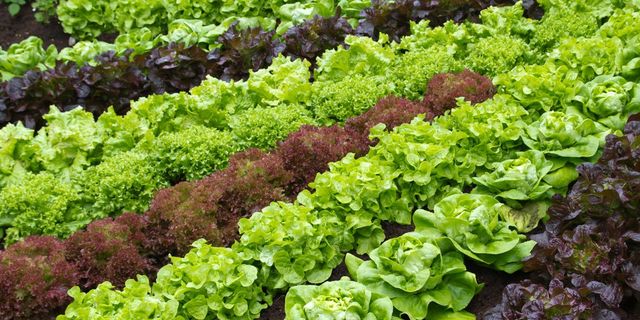Crop rotation is a systematic approach to deciding which crop to plant where in your vegetable garden from one year to the next. The goals of crop rotation are to help manage organic soil fertility and also to help avoid or reduce problems with soil-borne diseases and some soil-dwelling insects, such as corn rootworms.
Whether you're a large-scale organic farmer or home gardener, crop rotation can help replenish soil and benefit your harvest. The general principles of crop rotation, which we've outlined below, can help you devise a unique crop rotation plan depending on your needs. Here’s everything you need to know to get started.
(Sign up for our FREE newsletter to get clever kitchen tricks, gardening secrets, and more delivered straight to your inbox!)
Crop Rotation Helps Balance Soil Fertility
Different crops have different nutrient requirements and affect soil balance differently. Some, like corn and tomatoes, are heavy feeders that quickly deplete soil nitrogen and phosphorus. Thus, if you plant corn in the same spot year after year, that plot of soil will run low on nitrogen and phosphorus more quickly than other parts of your garden will. By changing the location of corn each year, you'll be able to renew the plot where it grew the preceding year, so your soil won't get out of balance.
There are other crops that also use up nitrogen rapidly. They tend to be the leafy and fruiting crops, such as lettuce, cabbage, and tomatoes. In contrast, root vegetables and herbs are light feeders. Peas, beans, and other legumes add nitrogen to the soil but need lots of phosphorus.
The general rule of thumb for balancing out soil nutrients is to avoid planting the same general category of crop (root, legume, and leafy/fruiting) successively in the same place. It's best to follow nitrogen-fixing legumes such as peas or beans with nitrogen-loving leaf or fruiting crops such as lettuce or tomatoes. Then, follow the heavy feeding crops with light-feeding root crops. (Also, check out these 7 secrets for a high yield vegetable garden, even when you're tight on space.)
It Also Prevents Plant-Killing Diseases And Pests
If you have a large home garden, you may want to plan your crop rotation on the basis of plant families rather than on nutrient needs. This can help in your overall program of avoiding diseases and pests, because crops in the same botanical family tend to suffer from the same pest and disease problems. For example, Colorado potato beetles like to eat potato plants, but they also enjoy feasting on tomato leaves and eggplant foliage. Since these beetles overwinter in the soil, if you plant eggplant in a spot where you grew potatoes the year before, you could be inviting a beetle problem for your eggplants from the day they're planted. Likewise, several serious bacterial and fungal diseases overwinter in plant debris in the soil.
Lengthy crop rotations are sometimes necessary to control chronic soil-borne problems. Bean anthracnose fungus can persist in soil for up to three years, so a four-year rotation is needed to keep the disease at bay. The same holds true for such fungal diseases as Fusarium wilt and Verticillium wilt. A few problems, such as club root, persist in the soil for even longer, so rotation is less useful for controlling them.
Determine Which Crop Rotation Method Is Best For You
If you have a small garden, you may not be able to set up an effective rotation by crop family. That's also true if you grow only a few kinds of crops. In that case, stick to a basic soil-balancing rotation.
If you have a large plot and grow many different crops, you may enjoy the challenge of setting up a rotation by crop family (see next slide for more information on crop families).
Keep in mind that cover crops can be included in a rotation plan to discourage specific types of pests and to improve soil (you should also consider companion planting). For example, beetle grubs thrive among most vegetables, but not in soil planted in buckwheat or clover. A season of either crop can greatly reduce grub populations and, at the same time, will increase soil organic matter content.
How To Rotate Crops By Vegetable Family
Susceptibility to pests and diseases runs in plant families. Leave at least two, and preferably three or more, years between the times you plant members of the same crop family in an area of your garden. When planning a crop rotation scheme, refer to the below rundown of the seven family groups most often planted in vegetable gardens, along with ideas for rotating them.
Plant group #1
Onions + Garlic
Crop rotation plan
Rotate with legumes, and avoid planting in soil with undecomposed organic matter.
Plant group #2
Carrots, Parsnips, Parsley, Dill, Fennel, Coriander
Crop rotation plan
Precede these moderate feeders with any other plant family, and condition soil with compost before planting. Follow with legumes or heavy mulch.
Plant group #3
Broccoli, Brussels Sprouts, Cabbage, Cauliflower, Kale, Kohlrabi, Radishes, Turnips
Crop rotation plan
For this group of heavy-feeding plants, a high level of soil maintenance is required for good root health. Precede them with legumes, and follow by first cultivating the soil to expose pests for predation, then spreading compost.
Plant group #4
Cucumbers, Gourds, Melons, Squash, Pumpkins, Watermelons
Crop rotation plan
For improved pest control, precede these plants with winter rye or wheat, and follow with legumes.
Plant group #5
Beans, Peas, Clovers, Vetches
Crop rotation plan
These plants are beneficial to soil and have few pest problems. Rotate them alternately with all other garden crops when possible.
Plant group #6
Wheat, Oats, Rye, Corn
Crop rotation plan
Plant these before tomato- or squash-family crops to control weeds and improve soil's ability to handle water.
Plant group #7
Eggplant, Peppers, Potatoes, Tomatoes
Crop rotation plan
These plants are heavy feeders with many fungal enemies. Precede with cereal grain or grass, and follow with legumes.














